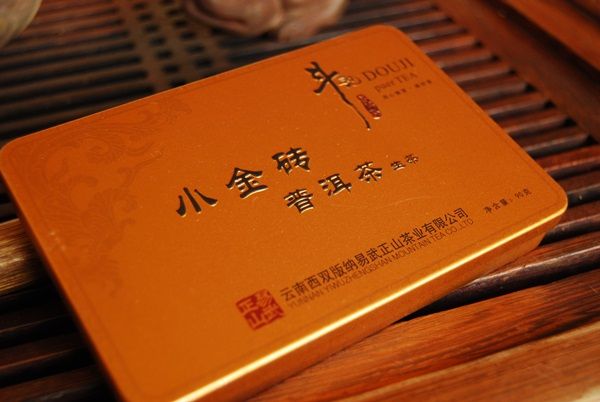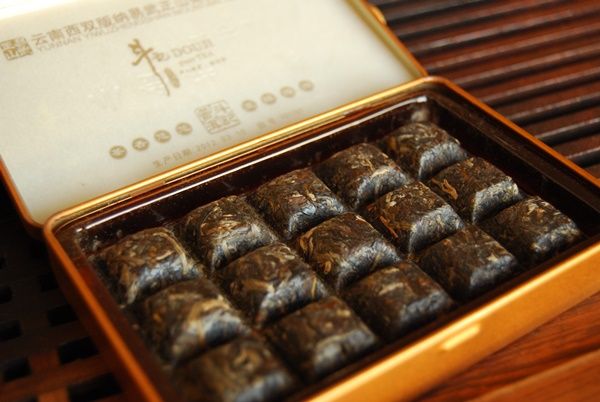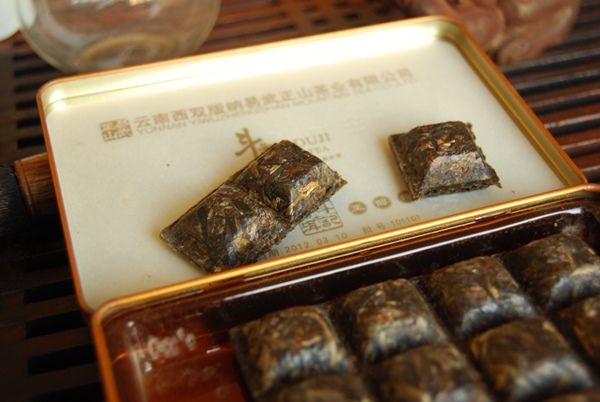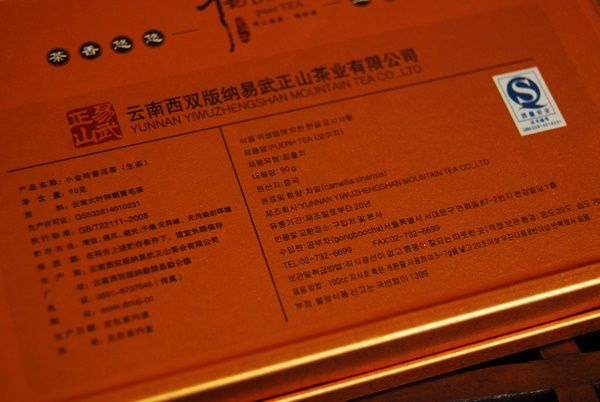Rule Number One when encountering a strangely-packaged tin of pu'ercha is usually: run a mile.
In the case of that tin containing small tuocha or, in this case, little squares of tea, the advice should be: run two miles.
However, you would be doing yourself a disservice if you did not keep an open mind in this instance, because, as we shall see, this pu'ercha that looks so stereotypically dreadful turns out to be really rather good.
The little "chocolate cubes" come apart with a snap, and the tiny leaves give no hint, in either appearance or scent, as to the final result.
Interestingly, I wonder if Douji has a significant market elsewhere in Asia - as shown below, one half of the text is in what appears to be another script.
The bricks are a 5x3 matrix, each weighing 6g, giving a total of 90g in the Xiaojinzhuan [little golden brick]. Unlike most "nibbles", such as the usually-grim mini-tuocha or mini-bricks mentioned before, these do give off a clean, sweet scent once they have sat in the air for a little while. "It smells like real tea", I have in my journal.
Likewise, the wenxiangbei [aroma cup] has the warm scent of real pu'ercha, which is something of a pleasant surprise. My previous experience with "convenience pu'ercha" of this kind has been of the grass cuttings and plantation variety.
I expect the first infusion to be underpowered, due to the tight compression which causes the leaves to take a few brews to separate. However, it is good right from the off: the soup is yellow (turning orange in the air, as pictured above), and the brew is penetrating, sweet, and surprisingly cooling.
Jerry was kind enough to send me this little box on its own, in a package after a recent batch of Douji samples that he knows I usually enjoy. The quality of this convenience tea really rather took me by surprise: it is lively, vivid, creamy (in the manner of many Douji blends), and worthwhile.
This looks like a tea that was born to travel, and perhaps I shall take it on my forthcoming round of academic visits. 2013 seems to have a grim mixture of Paris, Beijing, Qatar, Osaka, and Brunei lined up, and so I suspect this Little Gold Brick will be as exhausted as I will be at the end of it.







7 comments:
The script is Korean. Are there many pu-erh drinkers in Korea? I didn't get the sense that tea culture is as big there as it is in other East Asian countries.
I was wondering why Korean would appear on a Douji cake, but recall the ever-excellent Mattcha mentioning that there is something of a "scene" there. :)
Certainly, if you follow his blog, you will probably come to love the Korean taste for teaware - I always look on his cups with delight, for example!
Toodlepip,
Hobbes
Korea is a big and growing puerh market. Ask chrl42 :-)
Koreans buy a lot of high end arbor tree tea from China in recent years and probably douji would like to explore Korean market too.
Douji Export a lot their tea to Korea, they have to have Korean on their warping otherwise the custom will reject the tea! ^_^
They have been export tea to korea since 2006 i think!
Well, that explains the Korean. :)
Thanks!
The British as with the rest of the world have long since standardized on the metric system and so perhaps tea drinkers outside of the U.S. may run a kilometre on encountering overly elaborate tea packaging. But since a lot of us are not as fit as we ought to be, we may further reduce the minimum safe distance to a furlong or maybe even a chain.
The label states this tea is good for 20 years. The care descriptions must be for paper wrapped cakes as it states the tea should be kept in a well ventilated warm place (of 30C) out of direct sunlight. I'm not sure ventilation matters much to a tin such as this.
The surface looks unnaturally shiny. Any thoughts as to what it might be?
H
Thank you for breaking out your Korean skills!
While we use metric measurements for science, daily life in the UK retains Imperial units: our weight is measured in stones (not even lbs!), our road-signs measure distance in miles, and we buy pints of ale in the pub.
Perhaps I feel it even more acutely, as I was raised in Newmarket, a little settlement just outside Cambridge which is famous only for being the centre of the British horse-racing world. The town is populated more by thoroughbred racehorses than people. We measure in furlongs, perhaps unsurprisingly. We even have an Imperial unit of distance that you might not know: the "hand", equivalent to four inches, and which is used to measure the dimensions of a horse (typically up to its withers).
The Douji cubes do look shiny! This is just compression of the fur, however; the soup is quite normal.
Toodlepip,
Hobbes
Post a Comment